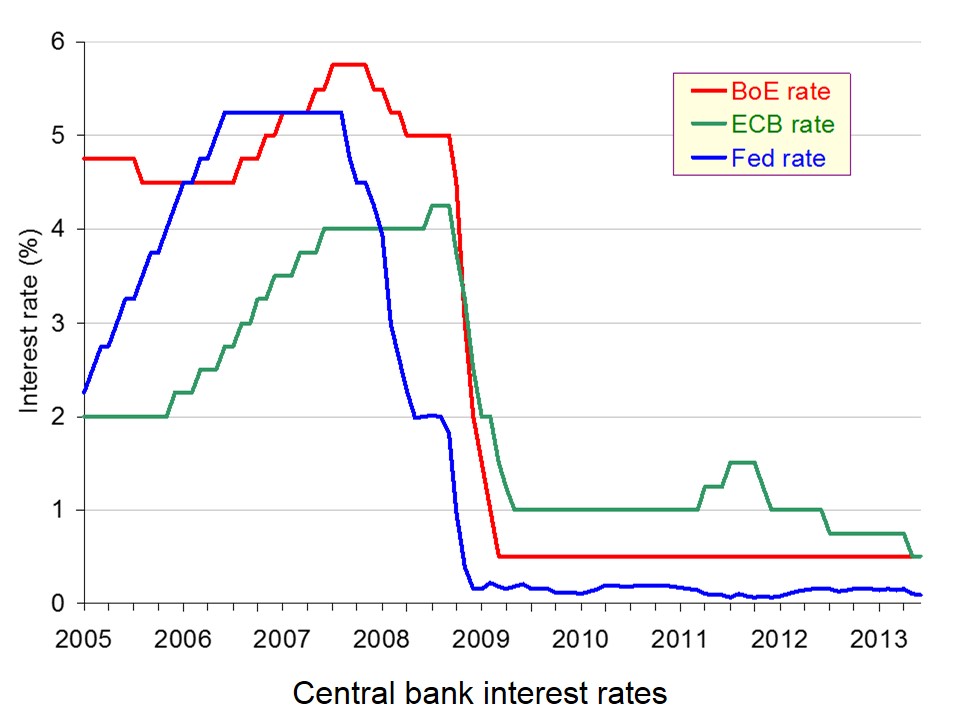 Since the beginning of 2009, central banks around the world have operated an extremely loose monetary policy. Their interest rates have been close to zero (click here for a PowerPoint of the chart) and more than $20 trillion of extra money has been injected into the world economy through various programmes of quantitative easing.
Since the beginning of 2009, central banks around the world have operated an extremely loose monetary policy. Their interest rates have been close to zero (click here for a PowerPoint of the chart) and more than $20 trillion of extra money has been injected into the world economy through various programmes of quantitative easing.
The most recent example of loose monetary policy has been in Japan, where substantial quantitative easing has been the first of Japan’s three arrows to revive the economy (the other two being fiscal policy and supply-side policy).
 One consequence of a rise in money supply has been the purchase of a range of financial assets, including shares, bonds and commodities. As a result, despite the sluggish or negative growth in most developed countries, stock markets have soared (see chart). From March 2009 to May 2013, the FTSE 100 rose by 91% and both the USA’s Dow Jones Industrial average and Germany’s DAX rose by 129%. Japan’s NIKKEI 225, while changing little from 2009 to 2012, rose by 78% from November 2012 to May 2013 (click here for a PowerPoint of the chart).
One consequence of a rise in money supply has been the purchase of a range of financial assets, including shares, bonds and commodities. As a result, despite the sluggish or negative growth in most developed countries, stock markets have soared (see chart). From March 2009 to May 2013, the FTSE 100 rose by 91% and both the USA’s Dow Jones Industrial average and Germany’s DAX rose by 129%. Japan’s NIKKEI 225, while changing little from 2009 to 2012, rose by 78% from November 2012 to May 2013 (click here for a PowerPoint of the chart).
The US economy has been showing stronger growth in recent months and, as a result, the Fed has indicated that it may soon have to begin tightening monetary policy. It is not doing so yet, nor are other central banks, but the concern that this may happen in the medium term has been enough to persuade many investors that stock markets are likely to fall as money eventually becomes tighter. Given the high degree of speculation on stock markets, this has led to a large-scale selling of shares as investors try to ‘get ahead of the curve’.
From mid-May to mid-June, the FTSE 100 fell by 6.2%, the Dow Jones by 2.6%, the DAX by 4.5% and the NIKKEI by 15%. In some developing countries, the falls have been steeper as the cheap money that entered their economies in search of higher returns has been leaving. The falls in their stock markets have been accompanied by falls in their exchange rates.
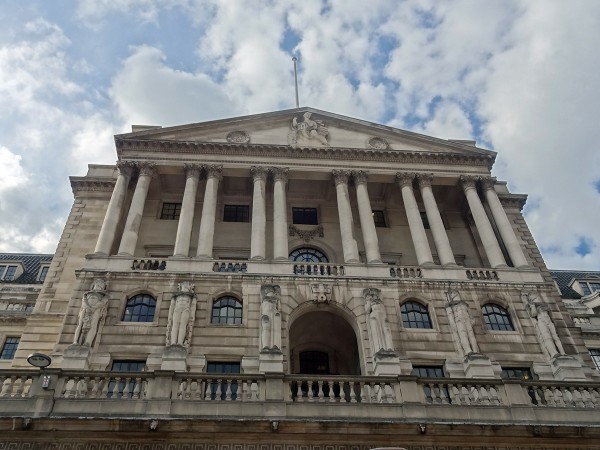 The core of the problem is that most of the extra money that was created by central banks has been used for asset purchase, rather than in financing extra consumer expenditure or capital investment. If money is tightened, it is possible that not only will stock and bond markets fall, but the fragile recovery may be stifled. In other words, tighter money and higher interest rates may indeed affect the real economy, even though loose monetary policy and record low interest rates had only a very modest effect on the real economy.
The core of the problem is that most of the extra money that was created by central banks has been used for asset purchase, rather than in financing extra consumer expenditure or capital investment. If money is tightened, it is possible that not only will stock and bond markets fall, but the fragile recovery may be stifled. In other words, tighter money and higher interest rates may indeed affect the real economy, even though loose monetary policy and record low interest rates had only a very modest effect on the real economy.
This poses a very difficult question for central banks. If even the possibility of monetary tightening some time in the future has spooked markets and may rebound on the real economy, does that compel central banks to maintain their loose policy? If it does, will this create an even bigger adjustment problem in the future? Or could there be a ‘soft landing’, whereby real growth absorbs the extra money and gradually eases the inflationary pressure on asset markets?
Articles
How the Fed bosses all BBC News, Robert Peston (12/6/13)
The great reversal? Is the era of cheap money ending? BBC News, Linda Yueh (12/6/13)
The Great Reversal: Part II (volatility and the real economy) BBC News, Linda Yueh (14/6/13)
The end of the affair The Economist (15/6/13)
Out of favour The Economist, Buttonwood (8/6/13)
The Federal Reserve: Clearer, but less cuddly The Economist (22/6/13)
Global financial markets anxious to avoid many pitfalls of ‘political risk’ The Guardian, Heather Stewart (13/6/13)
Dow Falls Below 15,000; Retailers Add to Slump New York Times, (12/6/13)
Global market sell-off over stimulus fears The Telegraph, Rachel Cooper (13/6/13)
Nikkei sinks over 800 points, falls into bear market Globe and Mail (Canada), Lisa Twaronite (13/6/13)
Global shares drop, dollar slumps as rout gathers pace Reuters, Marc Jones (13/6/13)
The G8, the bond bubble and emerging threats BBC News, Stephanie Flanders (17/6/13)
Global monetary policy and the Fed: vive la difference BBC News, Stephanie Flanders (20/6/13)
The Federal Reserve’s dysfunctional relationship with the markets The Guardian, Heidi Moore (19/6/13)
Global stock markets in steep falls after Fed comment BBC News (20/6/13)
Federal Reserve’s QE withdrawal could signal real trouble ahead The Guardian, Nils Pratley (20/6/13)
Central banks told to head for exit Financial Times, Claire Jones (23/6/13)
Stimulating growth threatens stability, central banks warn The Guardian (23/6/13)
BIS Press Release and Report
Making the most of borrowed time: repair and reform the only way to growth, says BIS in 83rd Annual Report BIS Press Release (23/6/13)
83rd BIS Annual Report 2012/2013 Bank for International Settlements (23/6/13)
Data
Yahoo! Finance: see links for FTSE 100, DAX, Dow Jones, NIKKEI 225
Link to central bank websites Bank for International Settlements
Statistical Interactive Database – Interest & exchange rates data Bank of England
Questions
- Why have stock markets soared in recent years despite the lack of economic growth?
- What is meant by ‘overshooting’? Has overshooting taken place in stock markets (a) up to mid-May this year; (b) since mid-May? How would you establish whether overshooting has taken place?
- What role is speculation currently playing in stock markets? Would you describe this speculation as destabilising?
- What has been the impact of quantitative easing on (a) bond prices; (b) bond yields?
- Argue the case for and against central banks continuing with the policy of quantitative easing for the time being.
- Find out how much the Indian rupee and the Brazilian real have fallen in recent weeks. Explain your findings.
 With many countries struggling to recover from the depression of the past few years, central banks are considering more and more doveish moves to kick-start lending. But with short-term interest rates in the USA, the UK and Japan close to zero, the scope for further cuts are limited. So what can central banks do?
With many countries struggling to recover from the depression of the past few years, central banks are considering more and more doveish moves to kick-start lending. But with short-term interest rates in the USA, the UK and Japan close to zero, the scope for further cuts are limited. So what can central banks do?
The first thing that can be done is to adopt a higher inflation target or to accept inflation above target – at least for the time being. This could be accompanied by explicitly targeting GDP growth (real or nominal) or unemployment (see the blog from last December, Rethinking central bank targets).
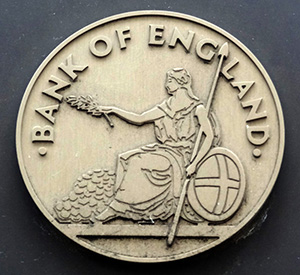 The second option is to increase quantitative easing. Although in a minority at the last MPC meeting, Mervyn King, the current Bank of England Governor, argued for a further £25 billion of asset purchases (bringing the total to £400bn) (see MPC minutes paragraph 39). It is highly likely that the MPC will agree to further QE at its next meeting in March. In Japan, the new governor of the Bank of Japan is expected to include asset purchases as part of the policy of monetary easing.
The second option is to increase quantitative easing. Although in a minority at the last MPC meeting, Mervyn King, the current Bank of England Governor, argued for a further £25 billion of asset purchases (bringing the total to £400bn) (see MPC minutes paragraph 39). It is highly likely that the MPC will agree to further QE at its next meeting in March. In Japan, the new governor of the Bank of Japan is expected to include asset purchases as part of the policy of monetary easing.
The third option is for the central bank to provide finance at below-market rates of interest directly to the banking sector specifically for lending: e.g. to small businesses or for house purchase. The Bank of England’s Funding for Lending Scheme is an example and the Bank is considering extending it to other financial institutions.
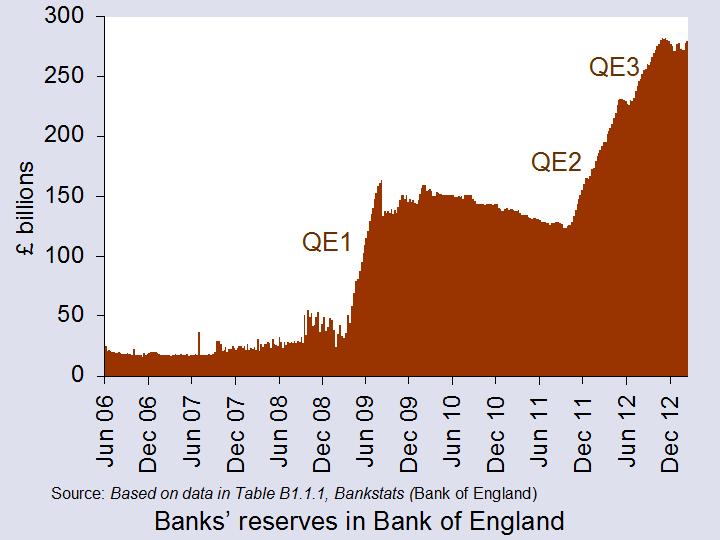 One other approach, mooted by the Bank of England’s Deputy Governor before the House of Commons Treasury Select Committee, is for negative interest rates paid on Banks’ reserves in the Bank of England. This would, in effect, be a fee levied on banks for keeping money on deposit. The idea would be to encourage banks to lend the money and not to keep excessive liquidity. As you can see from the chart, three rounds of quantitative easing have led to a huge increase in bank’s reserves at the Bank of England. (Click here for a PowerPoint of the chart.)
One other approach, mooted by the Bank of England’s Deputy Governor before the House of Commons Treasury Select Committee, is for negative interest rates paid on Banks’ reserves in the Bank of England. This would, in effect, be a fee levied on banks for keeping money on deposit. The idea would be to encourage banks to lend the money and not to keep excessive liquidity. As you can see from the chart, three rounds of quantitative easing have led to a huge increase in bank’s reserves at the Bank of England. (Click here for a PowerPoint of the chart.)
The following articles consider these various proposals and whether they will work to stimulate lending and thereby aggregate demand and economic recovery.
Central banks: Brave new words The Economist (23/2/13)
Phoney currency wars The Economist (16/2/13)
Analysis: Global central banks will keep taking it easy Reuters, Alan Wheatley (22/2/13)
Quantitative easing: the markets are struggling with a serious drug habi The Guardian, Larry Elliott (24/2/13)
Negative interest rates idea floated by Bank’s Paul Tucker BBC News (26/2/13)
Bank of England mulls negative interest rates Independent, Ben Chu (26/2/13)
BoE floats extending Funding for Lending to non-banks Mortgage Solutions, Adam Williams (26/2/13)
Funding for Lending Scheme failing to get banks lending Left Foot Forward, James Bloodworth (26/2/13)
Mortgage market boosted by lending schemes, says Redrow BBC News (26/2/13)
Widespread quantitative easing risks ‘QE wars’ and stagnation The Guardian, Nouriel Roubini (28/2/13)
Questions
- Consider each of the methods outlined above and their chances of success in stimulating aggregate demand.
- Go through each of the methods and consider the problems they are likely to create/have created.
- How important is it that monetary policy measures affect people’s expectations?
- What effects do the measures have on the distribution of income between borrowers and savers?
- What are annuities? How are these affected by policies of monetary easing?
- How has actual and anticipated Japanese monetary policy affected the exchange rate of the Japanese yen? How is this likely to affect the Japanese economy?
- Explain the sub-heading of the final article above, “When several major central banks pursue QE at the same time, it becomes a zero-sum game”. Do you agree?
 With the UK and eurozone economies in recession and with business and consumer confidence low, the Bank of England and the ECB have sprung into action.
With the UK and eurozone economies in recession and with business and consumer confidence low, the Bank of England and the ECB have sprung into action.
The ECB has cut its main refinancing rate from 1% to an all-time low of 0.75%. Meanwhile, the Bank of England has embarked on a further round of quantitative easing (QE). The MPC voted to inject a further £50 billion through its asset purchase scheme, bring the total to £375 billion since QE began in March 2009.
And it is not just in Europe that monetary policy is being eased. In Australia and China interest rates have been cut. In the USA, there have been further asset purchases by the Fed and it is expected that the Japanese central bank will cut rates very soon, along with those in Korea, Indonesia and Sri Lanka.
But with consumers seeming reluctant to spend and businesses being reluctant to invest, will the new money in the UK and elsewhere actually be lent and spent? Or will it simply sit in banks, boosting their liquidity base, but doing little if anything to boost aggregate demand?
And likewise in the eurozone, will a 25 basis point reduction in interest rates (i.e. a 0.25 percentage point reduction) do anything to boost borrowing and spending?
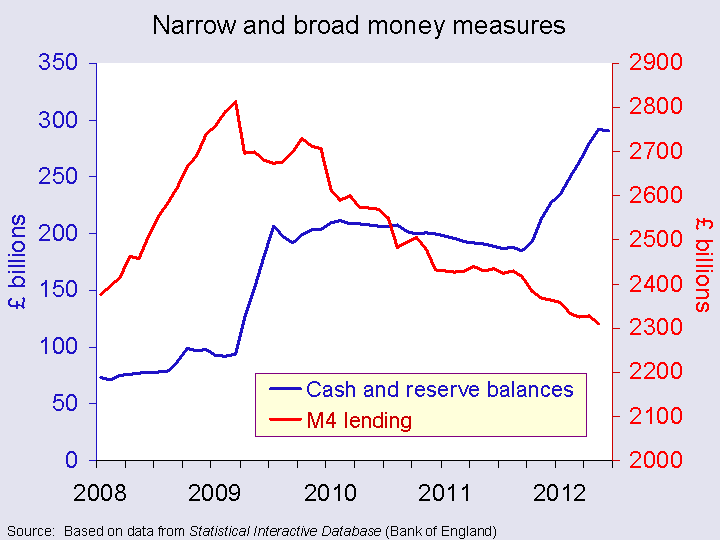 It is like pushing on a string – a term used by Keynesians to refer to the futile nature of monetary policy when people are reluctant to spend. Indeed the evidence over the past few years since QE started is that despite narrow money having risen massively, M4 lending has declined (see chart).
It is like pushing on a string – a term used by Keynesians to refer to the futile nature of monetary policy when people are reluctant to spend. Indeed the evidence over the past few years since QE started is that despite narrow money having risen massively, M4 lending has declined (see chart).
For a PowerPoint of the chart, click here.
The following articles look at the conundrum
Articles
Draghi-King Push May Mean Bigger Step Into Zero-Rate Era BloombergBusinessweek, Simon Kennedy (4/7/12)
QE and rate cut as central banks play stimulus card Independent, Ben Chu (6/7/12)
QE is welcome, but not enough Independent, Leader (6/7/12)
Interest rates cut to spur growth China Daily, Wang Xiaotian, Ding Qingfen and Gao Changxin (6/7/12)
Rate cuts shake global confidence Sydney Morning Herald, Eric Johnston, Clancy Yeates and Peter Cai (7/7/12)
Global Policy Easing Presses Asia to Cut Rates BloombergBusinessweek, Sharon Chen and Justina Lee (6/7/12)
Economic slowdown raises alarm in China, Europe Globe and Mail, Kevin Carmichael (5/7/12)
Bank of England sets sail with QE3 BBC News, Stephanie Flanders (5/7/12)
The twilight of the central banker The Economist (26/6/12)
The case for truly bold monetary policy Financial Times, Martin Wolf (28/6/12)
Questions
- Is the world economy in a liquidity trap?
- What advice would you give politicians around the world seeking to boost consumer and business confidence?
- Are we witnessing “The twilight of the central banker”? (See The Economist article above.)
- Explain the following extracts from the Martin Wolf article: “In a monetary system, based on fiat (or man-made) money, the state guarantees the money supply in the interests of the public. In normal times, however, actual supply is a byproduct of lending activities of banks. It is, in brief, the product of privately operated printing presses… In the last resort, the power to create money rests properly with the state. When private sector supply is diminishing, as now, the state not only can, but should, step in, with real urgency.”
- Should monetary policy in the UK be combined with fiscal policy in providing a stimulus at a time when the government can borrow ultra cheaply from the Bank of England? Does this apply to other governments around the world?
- Why did Asian share prices fall despite the stimulus?
The debts of many countries in the eurozone are becoming increasingly difficult to service. With negative growth in some countries (Greece’s GDP is set to decline by over 5% this year) and falling growth rates in others, the outlook is becoming worse: tax revenues are likely to fall and benefit payments are likely to increase as automatic fiscal stabilisers take effect. In the light of these difficulties, market rates of interest on sovereign debt in these countries have been increasing.
Talk of default has got louder. If Greece cannot service its public-sector debt, currently standing at around 150% of GDP (way above the 60% ceiling set in the Stability and Growth Pact), then simply lending it more will merely delay the problem. Ultimately, if it cannot grow its way out of the debt, then either it must receive a fiscal transfer from the rest of the eurozone, or part of its debts must be cancelled or radically rescheduled.
But Greece is a small country, and relative to the size of the whole eurozone’s GDP, its debt is tiny. Italy is another matter. It’s public-sector debt to GDP ratio, at around 120% is lower than Greece’s, but the level of debt is much higher: $2 trillion compared with Greece’s $480 billion. Increasingly banks are becoming worried about their exposure to Italian debt – both public- and private-sector debt.
As we saw in the news item “The brutal face of supply and demand”, stock markets have been plummeting because of the growing fears about debts in the eurozone. And these fears have been particularly focused on banks with high levels of exposure to these debts. French banks are particularly vulnerable. Indeed, Credit Agricole and Société Générale, France’s second and third largest banks, had their creidit ratings cut by Moody’s rating agency. They have both seen their share prices fall dramatically this year: 46% and 55% respectively.
Central banks have been becoming increasingly concerned that the sovereign debt crisis in various eurozone countries will turn into a new banking crisis. In an attempt to calm markets and help ease the problem for banks, five central banks – the Federal Reserve, the ECB, the Bank of England, the Bank of Japan and the Swiss National Bank – announced on 15 September that they would co-operate to offer three-month US dollar loans to commercial banks. They would provide as much liquidity as was necessary to ease any funding difficulties.
The effect of this action calmed the markets and share prices in Europe and around the world rose substantially. But was this enough to stave off a new banking crisis? And did it do anything to ease the sovereign debt crisis and the problems of the eurozone? The following articles explore these questions.
Articles
Central banks expand dollar operations Reuters, Sakari Suoninen and Marc Jones (15/9/11)
Europe’s debt crisis prompts central banks to provide dollar liquidity Guardian, Larry Elliott and Dominic Rushe (15/9/11)
From euro zone to battle zone Sydney Morning Herald, Michael Evans (17/9/11)
Global shares rise on central banks’ loan move BBC News (16/9/11)
Geithner warns EU against infighting over Greece BBC News (16/9/11)
How The European Debt Crisis Could Spread npr (USA), Marilyn Geewax (15/9/11)
No Marshall Plan for Europe National Post (Canada) (16/9/11)
Central banks act to help Europe lenders Financial Times, Ralph Atkins, Richard Milne and Alex Barker (15/9/11)
Central Banks Seeking Quick Fix Push Dollar Cost to August Lows Bloomberg Businesweek, John Glover and Ben Martin (15/9/11)
Central banks act to provide euro zone dollar liquidity Irish Times (15/9/11)
Central banks pump money into market: what the analysts say The Telegraph (15/9/11)
Central banks and the ‘spirit of 2008’ BBC News, Stephanie Flanders (15/9/11)
Central Bank statements
News Release: Additional US dollar liquidity-providing operations over year-end Bank of England (15/9/11)
Press Release: ECB announces additional US dollar liquidity-providing operations over year-end ECB (15/9/11)
Additional schedule for U.S. Dollar Funds-Supplying Operations Bank of Japan (15/9/11)
Central banks to extend provision of US dollar liquidity Swiss National Bank (15/9/11)
Questions
- Explain what is meant by debt servicing.
- How may the concerted actions of the five central banks help the banking sector?
- Distinguish between liquidity and capital. Is supplying extra liquidity a suitable means of coping with the difficulties of countries in servicing their debts?
- If Greece cannot service its debts, what options are open to (a) Greece itself; (b) international institutions and governments?
- In what ways are the eurozone countries collectively in a better economic and financial state than the USA?
- Is the best solution to the eurozone crisis to achieve greater fiscal harmonisation?
- What are the weaknesses of the European Financial Stability Facility (EFSF) as currently constituted? Should it be turned into a bank or special credit institution taking the role of a ‘European Monetary Fund’?
- Should countries in the eurozone be able to issue eurobonds?
The price of gold has hit a record high of over $1282 per ounce. By contrast, in 2007 it was trading at under $700 per ounce and in 2001 at under $300 per ounce. Various uncertainties in the world economy have led to large rises in the demand for gold by both central banks and investors in general.
But why has the gold price risen so dramatically and what is likely to happen to the price in the coming days and months? Some commentators are saying that the gold price has further to rise. Others are saying that it is already over priced! The following articles look at the explanations and the arguments.
Articles
Monetary easing fears lift gold to record high Financial Times, Javier Blas (17/9/10)
Five-fold rise in gold price ‘is not a bubble’, claims industry body Independent on Sunday, Mark Leftly (19/9/10)
Gold Prices Today Are Increasing to Record Levels Business and Finance News, Aidan Lamar (18/9/10)
Gold hits new peak of $1,283 Telegraph, Richard Evans (17/9/10)
Gold hits new record high Guardian, Julia Kollewe (17/9/10)
Gold prices – the highs and lows since 1971 Guardian, Julia Kollewe (17/9/10)
Gold is overpriced, so be wary of those ads to buy it Idaho Statesman, Peter Crabb (17/9/10)
Data
Gold prices World Gold Council
Commodity price data (including gold) BBC Business: Commodities
Questions
- Why has the price of gold risen? Illustrate your arguments with a demand and supply diagram.
- How are these demand and supply factors likely to change in the near future?
- What is the role of speculation in the determination of the gold price? What particular factors are speculators taking into account at the moment?
- Why have actions by the Bank of Japan (see A Japanese yen for recovery) influenced the gold price?
- Why have possible future actions by the US Federal Reserve Bank influenced the gold price?
 Since the beginning of 2009, central banks around the world have operated an extremely loose monetary policy. Their interest rates have been close to zero (click here for a PowerPoint of the chart) and more than $20 trillion of extra money has been injected into the world economy through various programmes of quantitative easing.
Since the beginning of 2009, central banks around the world have operated an extremely loose monetary policy. Their interest rates have been close to zero (click here for a PowerPoint of the chart) and more than $20 trillion of extra money has been injected into the world economy through various programmes of quantitative easing. One consequence of a rise in money supply has been the purchase of a range of financial assets, including shares, bonds and commodities. As a result, despite the sluggish or negative growth in most developed countries, stock markets have soared (see chart). From March 2009 to May 2013, the FTSE 100 rose by 91% and both the USA’s Dow Jones Industrial average and Germany’s DAX rose by 129%. Japan’s NIKKEI 225, while changing little from 2009 to 2012, rose by 78% from November 2012 to May 2013 (click here for a PowerPoint of the chart).
One consequence of a rise in money supply has been the purchase of a range of financial assets, including shares, bonds and commodities. As a result, despite the sluggish or negative growth in most developed countries, stock markets have soared (see chart). From March 2009 to May 2013, the FTSE 100 rose by 91% and both the USA’s Dow Jones Industrial average and Germany’s DAX rose by 129%. Japan’s NIKKEI 225, while changing little from 2009 to 2012, rose by 78% from November 2012 to May 2013 (click here for a PowerPoint of the chart). The core of the problem is that most of the extra money that was created by central banks has been used for asset purchase, rather than in financing extra consumer expenditure or capital investment. If money is tightened, it is possible that not only will stock and bond markets fall, but the fragile recovery may be stifled. In other words, tighter money and higher interest rates may indeed affect the real economy, even though loose monetary policy and record low interest rates had only a very modest effect on the real economy.
The core of the problem is that most of the extra money that was created by central banks has been used for asset purchase, rather than in financing extra consumer expenditure or capital investment. If money is tightened, it is possible that not only will stock and bond markets fall, but the fragile recovery may be stifled. In other words, tighter money and higher interest rates may indeed affect the real economy, even though loose monetary policy and record low interest rates had only a very modest effect on the real economy.



